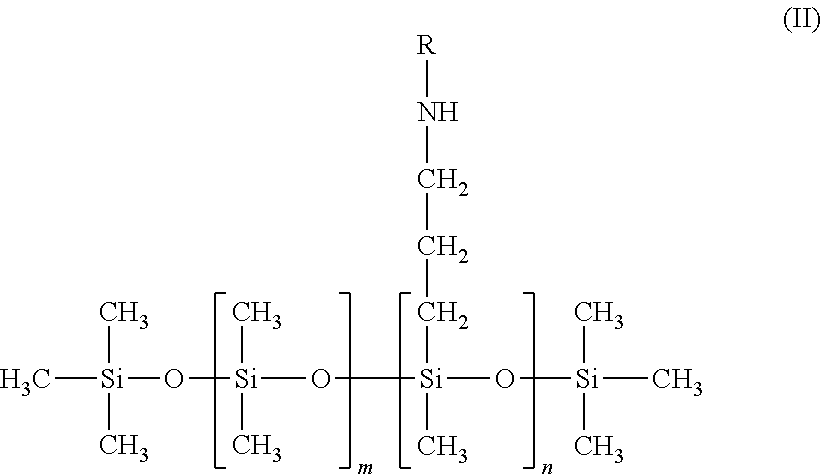Super high permeance and high selectivity rubbery polymeric membranes for separations
a high selectivity, rubbery polymer technology, applied in the direction of gaseous fuels, separation processes, membranes, etc., can solve the problems of low permeation rate or flux, olefin recovery, liquefied, etc., and achieve high selectivity, efficient and cost-effective recovery of both h2 and lpg
- Summary
- Abstract
- Description
- Claims
- Application Information
AI Technical Summary
Benefits of technology
Problems solved by technology
Method used
Image
Examples
example 1
Preparation of 5DMS-Si / 8DMS-A-DMS-E / PES-b Membrane
[0043]A porous, asymmetric PES gas separation support membrane (PES-b) was prepared via the phase-inversion process. A PES-b membrane casting dope comprising PES 20-25 wt %, NMP 60-65 wt %, 1,3-dioxolane 10-15 wt %, glycerol 1-10 wt % and n-decane 0.5-2 wt % was cast on a nylon fabric then gelled by immersion in a 1° C. water bath for about 10 minutes, and then annealed in a hot water bath at 85° C. for about 5 minutes. The wet membrane was dried at 70° C. A 5 wt % DMS-Si pre-cross-linked rubbery polymer solution was prepared by dissolving 6.3 g of fumed silica reinforced vinyl-terminated polydimethylsiloxane (Gelest catalog number: DMS-V31 S 15) and 0.7 g of RTV615B (Momentive) in 133 g of hexane at room temperature for about 30 min. The dried PES-b porous support membrane was coated with the 5 wt % DMS-Si pre-cross-linked polydimethylsiloxane polymer solution, dried at room temperature for about 5 min, and then heated at 85° C. for...
specific embodiments
[0047]While the following is described in conjunction with specific embodiments, it will be understood that this description is intended to illustrate and not limit the scope of the preceding description and the appended claims.
[0048]A first embodiment of the invention is a process comprising a thin selective layer of a fumed silica reinforced, cross-linked polyorganosiloxane on top of a porous glassy polymer support membrane and a thin selective layer of a chemically cross-linked polyorganosiloxane rubbery polymer on top of the thin selective layer of the fumed silica reinforced, cross-linked polyorganosiloxane. An embodiment of the invention is one, any or all of prior embodiments in this paragraph up through the first embodiment in this paragraph wherein the porous glassy polymer support membrane is a polymer selected from the group consisting of polyethersulfone, polysulfone, polyimide, polyacrylonitrile, cellulose acetate, cellulose triacetate, and mixtures thereof. An embodime...
second embodiment
wherein n is an integer from 10 to 1000. An embodiment of the invention is one, any or all of prior embodiments in this paragraph up through the second embodiment in this paragraph wherein the aminoorganomethylsiloxane-dimethylsiloxane copolymer comprises a plurality of a repeating units of formula (II)
[0051]
wherein —R is —H or —CH2CH2NH2, wherein n and m are independent integers from 2 to 1000 and the molar ratio of n to m is in a range of 1500 to 15.
[0052]A third embodiment of the invention is a process for separating a mixture comprising contacting the mixture to a membrane comprising a thin selective layer of a fumed silica reinforced, cross-linked polyorganosiloxane on top of a porous glassy polymer support membrane and a thin selective layer of a chemically cross-linked polyorganosiloxane rubbery polymer on top of the thin selective layer of the fumed silica reinforced, cross-linked polyorganosiloxane. An embodiment of the invention is one, any or all of prior embodiments in t...
PUM
| Property | Measurement | Unit |
|---|---|---|
| molar ratio | aaaaa | aaaaa |
| thickness | aaaaa | aaaaa |
| thickness | aaaaa | aaaaa |
Abstract
Description
Claims
Application Information
 Login to View More
Login to View More - R&D
- Intellectual Property
- Life Sciences
- Materials
- Tech Scout
- Unparalleled Data Quality
- Higher Quality Content
- 60% Fewer Hallucinations
Browse by: Latest US Patents, China's latest patents, Technical Efficacy Thesaurus, Application Domain, Technology Topic, Popular Technical Reports.
© 2025 PatSnap. All rights reserved.Legal|Privacy policy|Modern Slavery Act Transparency Statement|Sitemap|About US| Contact US: help@patsnap.com



